Stocks & Indexes
By Colin Twiggs
November 11, 2006 2:30 p.m. AET (10:30 p.m. ET)
November 11, 2006 2:30 p.m. AET (10:30 p.m. ET)
These extracts from my daily trading diary are for educational
purposes and should not be interpreted as investment advice.
Full terms and conditions can be found at
Terms of Use. The next newsletter (an update on Gold, Crude
Oil and the Dollar) will be on Tuesday.
The Big Picture
There is profit-taking across a broad range of markets, perhaps
induced by the US mid-term elections and the uncertainty
resulting from the political shift. While there may be some
weakness, this does not amount to a change in the primary trend
which remains positive.
Crude oil is consolidating between $57 and $62/barrel. Whether this will lead to a reversal of the recent down-trend is too early to tell. The dollar continues to weaken, headed for a test of $1.30 against the euro, the high of the last 6 months. Gold continues in a strong up-trend after a bullish, short, mid-week retracement.
Probability of recession in the next four quarters remains at 41 per cent according to the Wright model. A climb above 50% would be cause for concern.
Crude oil is consolidating between $57 and $62/barrel. Whether this will lead to a reversal of the recent down-trend is too early to tell. The dollar continues to weaken, headed for a test of $1.30 against the euro, the high of the last 6 months. Gold continues in a strong up-trend after a bullish, short, mid-week retracement.
Probability of recession in the next four quarters remains at 41 per cent according to the Wright model. A climb above 50% would be cause for concern.
USA: Dow, NASDAQ & SP500
The Dow Industrial Average
encountered resistance at the October high of 12175,
highlighted by higher volume on Thursday [Th]. However,
Friday's
doji candle signals uncertainty and we could see another
attempt at a new high.
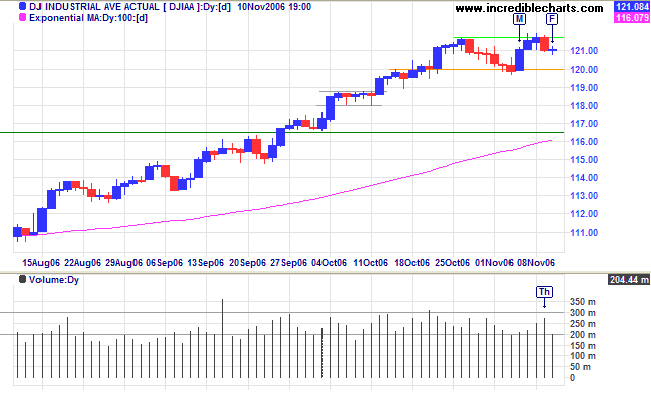
Medium Term: A fall below 12000 would signal a test of
the first line of primary support at 11650/11700. A close above
12175, on the other hand, would indicate that the target of
12700 (calculated as 11650 + {11650 - 10700}) is still
achievable.
Divergence on
Twiggs Money Flow (21-day) favors the bearish
scenario.
Long Term: The Dow is in a primary up-trend with support at 10700.
Long Term: The Dow is in a primary up-trend with support at 10700.
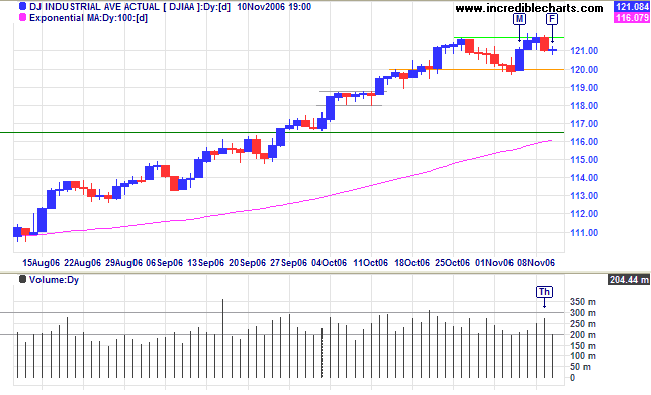
The Dow Jones Transportation Average respected support
at 4600 and appears ready to test resistance at 5000. A break
above the May high would signal reversal to a primary up-trend
and confirm the existence of a
bull market.
Note how closely the index shadows Fedex. Divergences between the two have often preceded a trend reversal in the past.
Note how closely the index shadows Fedex. Divergences between the two have often preceded a trend reversal in the past.
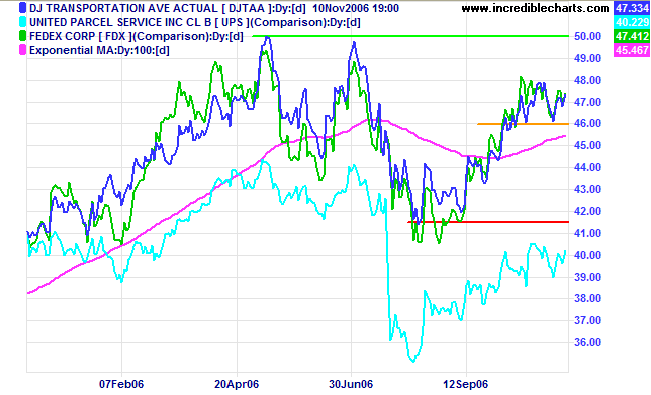
The Nasdaq Composite Index broke above its April high of
2370, a positive sign for the broader equity market, and the
Nasdaq 100 appears about to follow suit. Divergence on
Twiggs Money Flow (21-day) warns of a retracement, possibly
testing the 100-day
moving average.
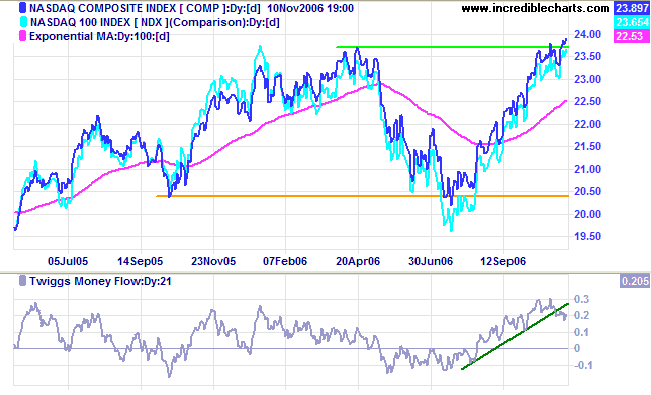
The S&P 500 is consolidating at the upper trend
channel (drawn at 2 standard deviations around a linear
regression line).
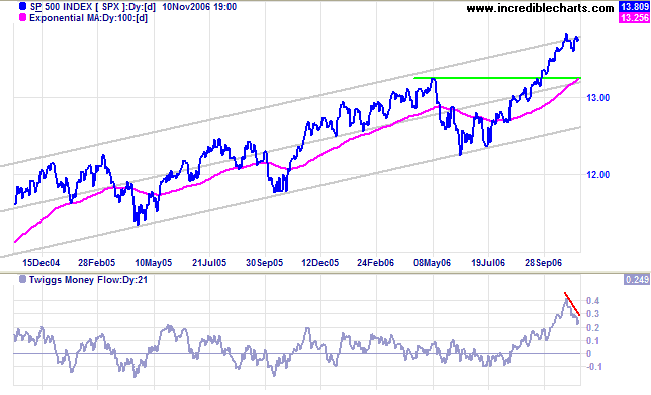
Medium Term:
Divergence on
Twiggs Money Flow (21-day) warns of a reversal to test the
lower border of the channel.
Long Term: The S&P 500 is in a primary up-trend with support at 1220.
Long Term: The S&P 500 is in a primary up-trend with support at 1220.
LSE: United Kingdom
The FTSE 100 respected support at 6100, but the marginal
new high warns of further weakness.
Medium Term: Twiggs Money Flow (21-day) exhibits a bearish triple divergence, warning of another test of support at 6100. Failure of this level would signal a secondary correction -- more serious because we are only marginally above the April high and a correction would be likely to test primary support at 5500. If, on the other hand, support at 6100 holds, the target of 6700 (calculated as 6100 + {6100 - 5500}) is still achievable.
Long Term: The primary up-trend continues.
Medium Term: Twiggs Money Flow (21-day) exhibits a bearish triple divergence, warning of another test of support at 6100. Failure of this level would signal a secondary correction -- more serious because we are only marginally above the April high and a correction would be likely to test primary support at 5500. If, on the other hand, support at 6100 holds, the target of 6700 (calculated as 6100 + {6100 - 5500}) is still achievable.
Long Term: The primary up-trend continues.
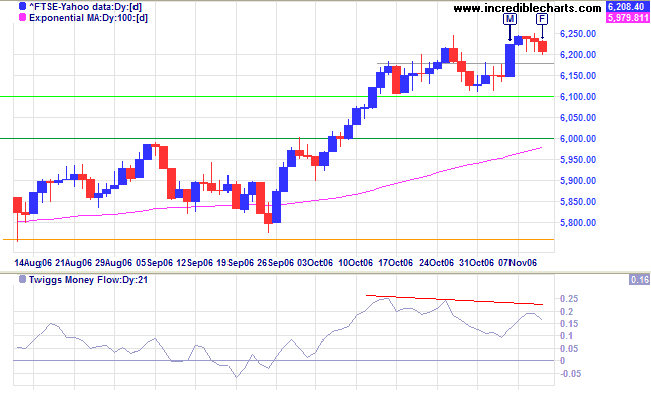
Nikkei: Japan
The Nikkei 225 penetrated the lower border of the trend
channel (drawn at 2 STD around a linear regression line) and is
headed for the 100-day moving
average. A clear break below these two lines would be a
bear signal.
Medium Term: Twiggs Money Flow (21-day) is also trending lower, a bearish sign. A retracement that respects the moving average (from below) would signal a test of primary support at 14200 -- more bearish because of the failure to reach 17500 and make a new high.
Long Term: The index remains in a primary up-trend.
Medium Term: Twiggs Money Flow (21-day) is also trending lower, a bearish sign. A retracement that respects the moving average (from below) would signal a test of primary support at 14200 -- more bearish because of the failure to reach 17500 and make a new high.
Long Term: The index remains in a primary up-trend.
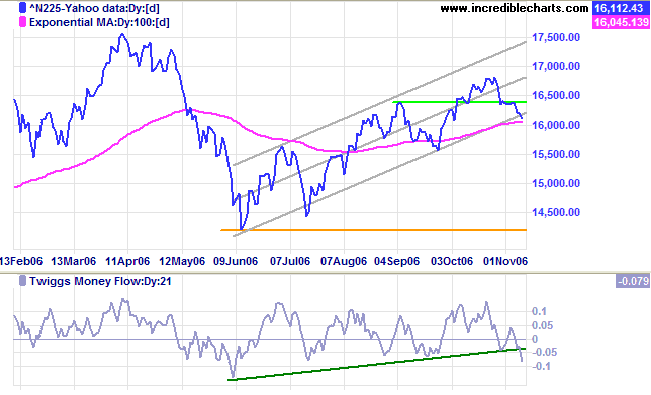
ASX: Australia
The All Ordinaries retraced for two days before
consolidating with an
inside day on Friday, strong volume indicating buying
support. A rise above Thursday's high would signal the start of
another (expected) short-term rally, while a fall below
Thursday's low would warn of another short-term down-swing to
test the new support level of 5320.
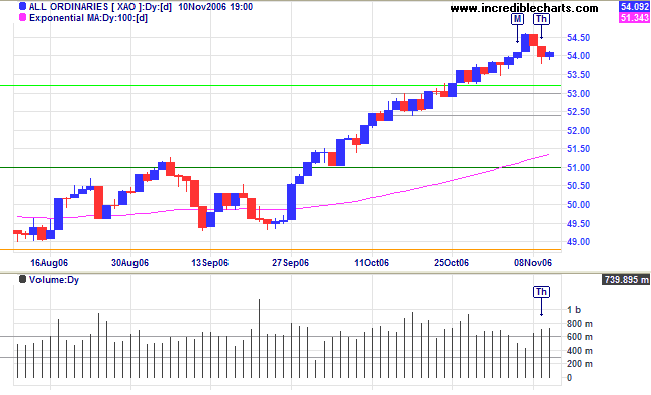
Medium Term: Expect a test of the upper border of the
trend channel (channel lines are drawn at 2 standard deviations
around a linear regression line).
Twiggs Money Flow (21-day) is above zero and trending
upwards, signaling long-term accumulation.
Long Term: The All Ordinaries remains in a primary up-trend with support at 4800.
Long Term: The All Ordinaries remains in a primary up-trend with support at 4800.
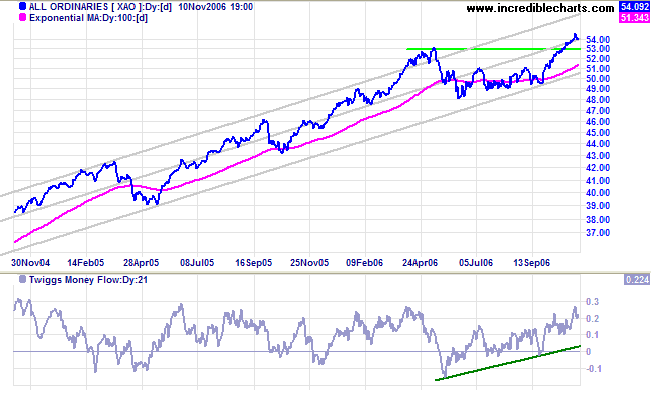
It is fatal to enter any war without the will
to win it.
~ General Douglas MacArthur
~ General Douglas MacArthur
|
Technical Analysis and Predictions I believe that Technical Analysis should not be used to make predictions because we never know the outcome of a particular pattern or series of events with 100 per cent certainty. The best that we can hope to achieve is a probability of around 80 per cent for any particular outcome: something unexpected will occur at least one in five times. My approach is to assign probabilities to each possible outcome. Assigning actual percentages would imply a degree of precision which, most of the time, is unachievable. Terms used are more general: "this is a strong signal"; "this is likely"; "expect this to follow"; "this is less likely to occur"; "this is unlikely"; and so on. Bear in mind that there are times, especially when the market is in equilibrium, when we may face several scenarios with fairly even probabilities. Analysis is also separated into three time frames: short, medium and long-term. While one time frame may be clear, another could be uncertain. Obviously, we have the greatest chance of success when all three time frames are clear. The market is a dynamic system. I often compare trading to a military operation, not because of its' oppositional nature, but because of the complexity, the continual uncertainty created by conflicting intelligence and the element of chance that can disrupt even the best made plans. Prepare thoroughly, but allow for the unexpected. The formula is simple: trade when probabilities are in your favor; apply proper risk (money) management; and you will succeed. For further background, please read About The Trading Diary. |
